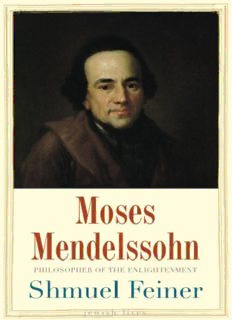
Moses Mendelssohn : Sage of Modernity PDF
Preview Moses Mendelssohn : Sage of Modernity
MOSES MENDELSSOHN Moses Mendelssohn Sage of Modernity SHMUEL FEINER Translated from the Hebrew by Anthony Berris New Haven and London Frontispiece: A fictitious meeting of, from left, Moses Mendelssohn, Gotthold Ephraim Lessing, and Johann Caspar Lavater; engraving after a painting by Moritz Daniel Oppenheim, 1856. akg-images. Copyright © 2010 by Shmuel Feiner. Translation copyright © 2010 by Anthony Berris. Hebrew edition copyright © 2005 by the Zalman Shazar Center, Jerusalem, Israel. First published in Hebrew as part of the biographies series Outstanding Minds and Creative Personalities in Jewish Histories. Chief Editor: Anita Shapira. Editorial Board Members: Avraham Grossman, Moshe Idel, Yosef Kaplan, Zvi Yekutiel. Published by arrangement with the Zalman Shazar Center. All rights reserved. This book may not be reproduced, in whole or in part, including illustrations, in any form (beyond that copying permitted by Sections 107 and 108 of the U.S. Copyright Law and except by reviewers for the public press), without written permission from the publishers. Set in Janson Oldstyle type by Tseng Information Systems, Inc. Printed in the United States of America. Library of Congress Cataloging-in-Publication Data Feiner, Shmuel. [Mosheh Mendelson. English] Moses Mendelssohn : sage of modernity / Shmuel Feiner ; translated from the Hebrew by Anthony Berris. p.(cid:11)cm. — (Jewish lives) Includes bibliographical references and index. ISBN 978-0-300-16175-5 (cloth : alk. paper) 1. Mendelssohn, Moses, 1729–1786. 2. Philosophers—Germany—Berlin—Biography. 3. Jews—Germany—Berlin—Biography. I. Title. B2693.F4513 2010 193—dc22 [B](cid:11)(cid:11)2010020778 A catalogue record for this book is available from the British Library. This paper meets the requirements of ANSI/NISO Z39.48-1992 (Permanence of Paper). 10(cid:2) 9(cid:2) 8(cid:2) 7(cid:2) 6(cid:2) 5(cid:2) 4(cid:2) 3(cid:2) 2(cid:2) 1 You must surely know what small part the members of my faith have in all the freedoms of this country. The civic oppression to which we are subject due to deep-rooted prejudice lies like a deadweight on the wings of the spirit and prevents any attempt to fly to the heights attained by those who were born free. —Moses Mendelssohn, 1762 I shall not deny that in my religion I have discerned additions and distortions made by Man which, alas, dull its splendor. What lover of truth can pride himself in that he found his entire religion pure of harmful man-made laws? We all seek the truth, we know the deleterious folly of hypocrisy and superstition, and hope we shall possess the ability to rid ourselves of it without damage to the true and the good. But I am truly convinced that the essence of my religion is immovable. —Moses Mendelssohn, 1770 This page intentionally left blank CONTENTS 1. A Stroll Down Unter den Linden, 1 2. From Dessau to Berlin: An Unpredicted Career, 17 3. Cultural Conversion: The Three Formative Years, 35 4. War and Peace, Love and Family, Fame and Frustration, 56 5. Affront and Sickness: The Lavater Affair, 83 6. Dreams, Nightmares, and Struggles for Religious Tolerance, 107 7. Jerusalem: The Road to Civic Happiness, 153 8. Specters: The Last Two Years, 187 Chronology, 217 Select Bibliography, 223 Index, 227 This page intentionally left blank 1 A Stroll Down Unter den Linden IN THE early evenings and on Sundays and holidays during the eighteenth century, many Berliners would take a pleasant stroll through the hunting grounds of the Tiergarten and down the linden-lined boulevard of Unter den Linden, which led to the royal palace. In the last decades of the century, the residents of the capital of the Kingdom of Prussia and numerous visitors to the city—who came to gain a firsthand impression of one of Europe’s nascent cities of culture—could see Jews mingling with the other strollers in the city’s parks and along its boule- vards. The presence of many members of Berlin’s Jewish com- munity, which numbered some three thousand souls, in public places and in cultural sites—particularly theaters and concert halls—was characteristic of life in the vibrant city. Wealthy Jews, successful merchants and entrepreneurs, promenaded with their wives and daughters in fashionable attire, elegant coiffures, and ostentatious wigs, their fluent German and their 1
Description: